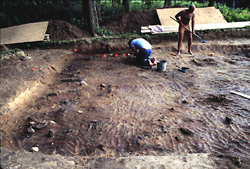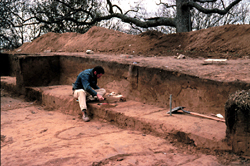
 |
|
The Morton Site excavation. |
Morton Site
The Morton site was first documented by archaeologists from the University of Chicago in 1930. Over the next few years, they explored parts of the village and cemetery areas of the site. Lying along the bluff top overlooking the Illinois River valley, the Morton site was home to Native Americans periodically over several hundred years.
The Morton site was revisited by archaeologists in 1983 to evaluate if improvements to a nearby highway would affect the site. Federal and state laws exist to protect important archaeological sites, and it was soon apparent that the construction would destroy a part of the Morton site. The Illinois Department of Transportation asked the Illinois State Museum to study the part of the site that would be destroyed, and Museum archaeologists conducted the excavation. They made notes, maps, and took photographs of the remains of houses and food storage pits. And, they collected hundreds of artifacts to learn what life was like at this part of the site, which was home to Native Americans from about 800 to 1200 years ago.
The results of the museum's study were published in a book titled "Archaeological Investigations at the Morton Village and Norris Farms 36 Cemetery." Artifacts, records, and photographs from the project are part of the museum's collection that is housed at Dickson Mounds Museum. Information from the report, notes, and the collection were used to prepare this MuseumLink module.
 |
|
Norris Farms #36 Site excavation. |
Norris Farms No. 36 Site
When University of Chicago archaeologists first visited the Morton Site in 1930, they did not recognize a low, oval mound of earth overlooking Illinois Route 78/97. In 1984, Dickson Mounds Museum archaeologists studying the Morton Site discovered the mound and named it after the corporation that owned the land, then the Norris Farms. The mound was the 36th site found on the Norris Farms property.
The mound was at the top of a steep slope that needed to be stabilized. Museum archaeologists were called in to document how the mound had been built and to remove the human remains. They discovered a 700-year-old cemetery used by Oneota people known. At the time, archaeologists knew very little about Oneota people and their way of life in Illinois.
Through careful excavation, archaeologists documented the cemetery. We now know much more about the Oneota. In particular, osteologists-scientists who study the skeleton-learned about how long people lived, how tall they were, how healthy they were, and they learned about how their society was organized (see Identity above). Osteologists were surprised to learn that these particular people suffered from conflict. Many had been badly injured or killed. Archaeologists do not know exactly who was involved in the conflict or why it occurred, but this information adds to our understanding of life in Illinois 300 years before the arrival of the first French explorers.
|
|
Copyright © 2000 Illinois State Museum